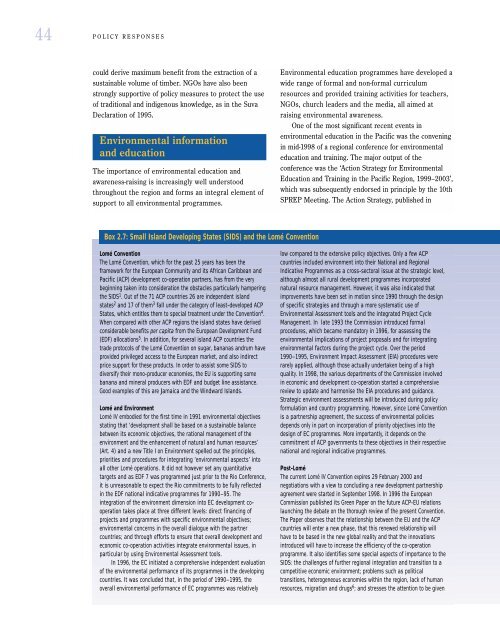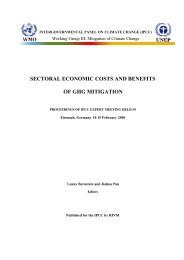Pacific Islands Environment Outlook - UNEP
Pacific Islands Environment Outlook - UNEP
Pacific Islands Environment Outlook - UNEP
You also want an ePaper? Increase the reach of your titles
YUMPU automatically turns print PDFs into web optimized ePapers that Google loves.
44<br />
POLICY RESPONSES<br />
could derive maximum benefit from the extraction of a<br />
sustainable volume of timber. NGOs have also been<br />
strongly supportive of policy measures to protect the use<br />
of traditional and indigenous knowledge, as in the Suva<br />
Declaration of 1995.<br />
<strong>Environment</strong>al information<br />
and education<br />
The importance of environmental education and<br />
awareness-raising is increasingly well understood<br />
throughout the region and forms an integral element of<br />
support to all environmental programmes.<br />
<strong>Environment</strong>al education programmes have developed a<br />
wide range of formal and non-formal curriculum<br />
resources and provided training activities for teachers,<br />
NGOs, church leaders and the media, all aimed at<br />
raising environmental awareness.<br />
One of the most significant recent events in<br />
environmental education in the <strong>Pacific</strong> was the convening<br />
in mid-1998 of a regional conference for environmental<br />
education and training. The major output of the<br />
conference was the ‘Action Strategy for <strong>Environment</strong>al<br />
Education and Training in the <strong>Pacific</strong> Region, 1999–2003’,<br />
which was subsequently endorsed in principle by the 10th<br />
SPREP Meeting. The Action Strategy, published in<br />
Box 2.7: Small Island Developing States (SIDS) and the Lomé Convention<br />
Lomé Convention<br />
The Lomé Convention, which for the past 25 years has been the<br />
framework for the European Community and its African Caribbean and<br />
<strong>Pacific</strong> (ACP) development co-operation partners, has from the very<br />
beginning taken into consideration the obstacles particularly hampering<br />
the SIDS 1 . Out of the 71 ACP countries 26 are independent island<br />
states 2 and 17 of them 3 fall under the category of least-developed ACP<br />
States, which entitles them to special treatment under the Convention 4 .<br />
When compared with other ACP regions the island states have derived<br />
considerable benefits per capita from the European Development Fund<br />
(EDF) allocations 5 . In addition, for several island ACP countries the<br />
trade protocols of the Lomé Convention on sugar, bananas andrum have<br />
provided privileged access to the European market, and also indirect<br />
price support for these products. In order to assist some SIDS to<br />
diversify their mono-producer economies, the EU is supporting some<br />
banana and mineral producers with EDF and budget line assistance.<br />
Good examples of this are Jamaica and the Windward <strong>Islands</strong>.<br />
Lomé and <strong>Environment</strong><br />
Lomé IV embodied for the first time in 1991 environmental objectives<br />
stating that ‘development shall be based on a sustainable balance<br />
between its economic objectives, the rational management of the<br />
environment and the enhancement of natural and human resources’<br />
(Art. 4) and a new Title I on <strong>Environment</strong> spelled out the principles,<br />
priorities and procedures for integrating ‘environmental aspects’ into<br />
all other Lomé operations. It did not however set any quantitative<br />
targets and as EDF 7 was programmed just prior to the Rio Conference,<br />
it is unreasonable to expect the Rio commitments to be fully reflected<br />
in the EDF national indicative programmes for 1990–95. The<br />
integration of the environment dimension into EC development cooperation<br />
takes place at three different levels: direct financing of<br />
projects and programmes with specific environmental objectives;<br />
environmental concerns in the overall dialogue with the partner<br />
countries; and through efforts to ensure that overall development and<br />
economic co-operation activities integrate environmental issues, in<br />
particular by using <strong>Environment</strong>al Assessment tools.<br />
In 1996, the EC initiated a comprehensive independent evaluation<br />
of the environmental performance of its programmes in the developing<br />
countries. It was concluded that, in the period of 1990–1995, the<br />
overall environmental performance of EC programmes was relatively<br />
low compared to the extensive policy objectives. Only a few ACP<br />
countries included environment into their National and Regional<br />
Indicative Programmes as a cross-sectoral issue at the strategic level,<br />
although almost all rural development programmes incorporated<br />
natural resource management. However, it was also indicated that<br />
improvements have been set in motion since 1990 through the design<br />
of specific strategies and through a more systematic use of<br />
<strong>Environment</strong>al Assessment tools and the integrated Project Cycle<br />
Management. In late 1993 the Commission introduced formal<br />
procedures, which became mandatory in 1996, for assessing the<br />
environmental implications of project proposals and for integrating<br />
environmental factors during the project cycle. Over the period<br />
1990–1995, <strong>Environment</strong> Impact Assessment (EIA) procedures were<br />
rarely applied, although those actually undertaken being of a high<br />
quality. In 1998, the various departments of the Commission involved<br />
in economic and development co-operation started a comprehensive<br />
review to update and harmonise the EIA procedures and guidance.<br />
Strategic environment assessments will be introduced during policy<br />
formulation and country programming. However, since Lomé Convention<br />
is a partnership agreement, the success of environmental policies<br />
depends only in part on incorporation of priority objectives into the<br />
design of EC programmes. More importantly, it depends on the<br />
commitment of ACP governments to these objectives in their respective<br />
national and regional indicative programmes.<br />
Post-Lomé<br />
The current Lomé IV Convention expires 29 February 2000 and<br />
negotiations with a view to concluding a new development partnership<br />
agreement were started in September 1998. In 1996 the European<br />
Commission published its Green Paper on the future ACP-EU relations<br />
launching the debate on the thorough review of the present Convention.<br />
The Paper observes that the relationship between the EU and the ACP<br />
countries will enter a new phase, that this renewed relationship will<br />
have to be based in the new global reality and that the innovations<br />
introduced will have to increase the efficiency of the co-operation<br />
programme. It also identifies some special aspects of importance to the<br />
SIDS: the challenges of further regional integration and transition to a<br />
competitive economic environment; problems such as political<br />
transitions, heterogeneous economies within the region, lack of human<br />
resources, migration and drugs 6 ; and stresses the attention to be given

















